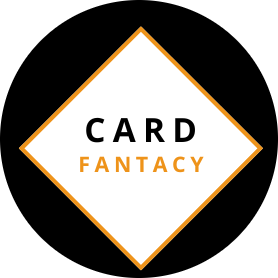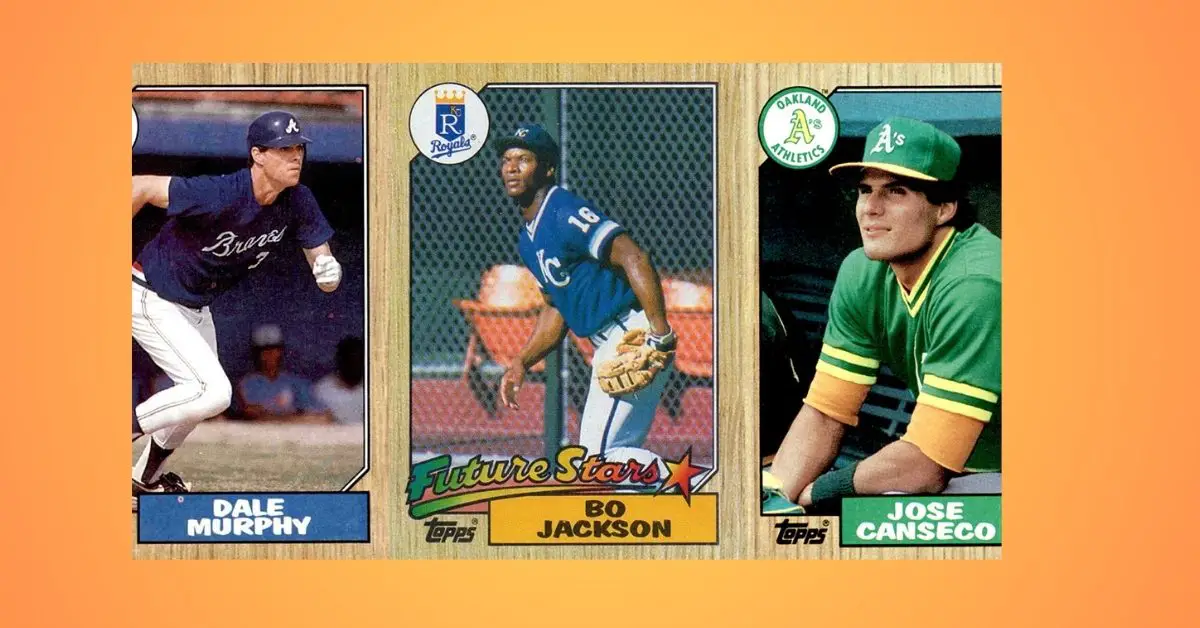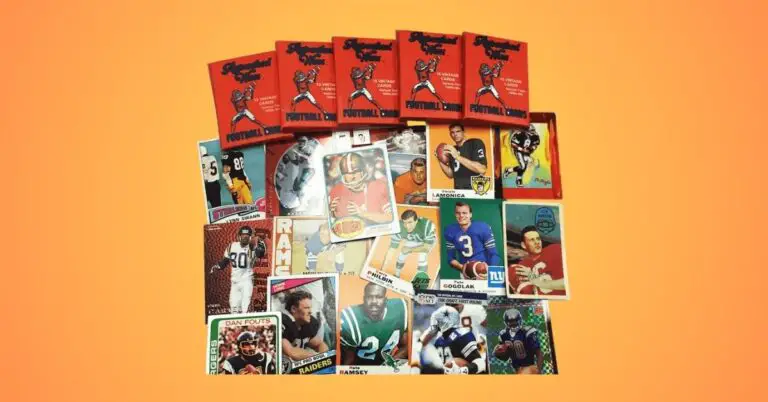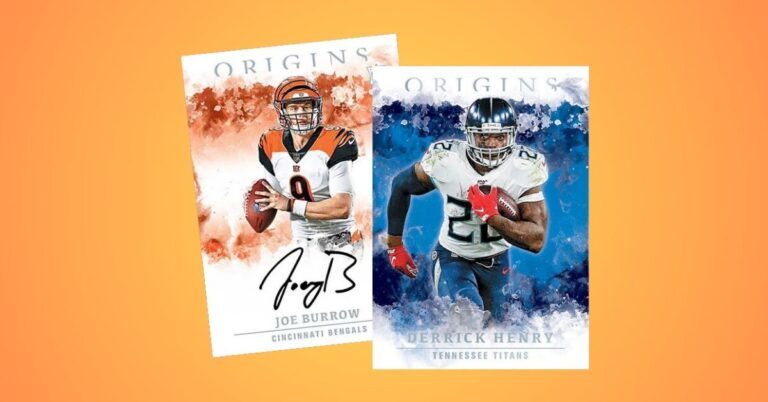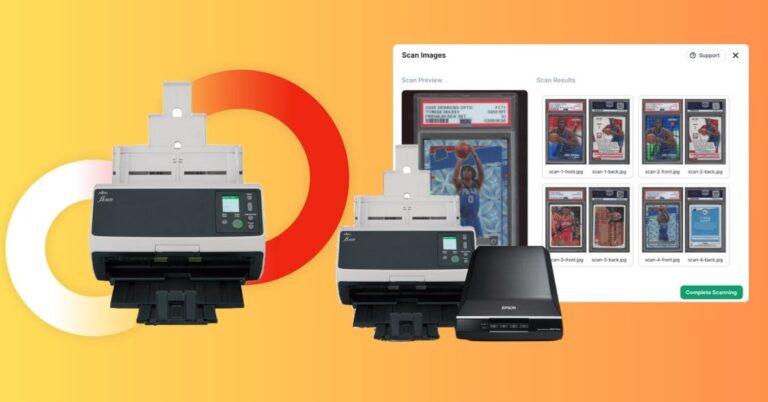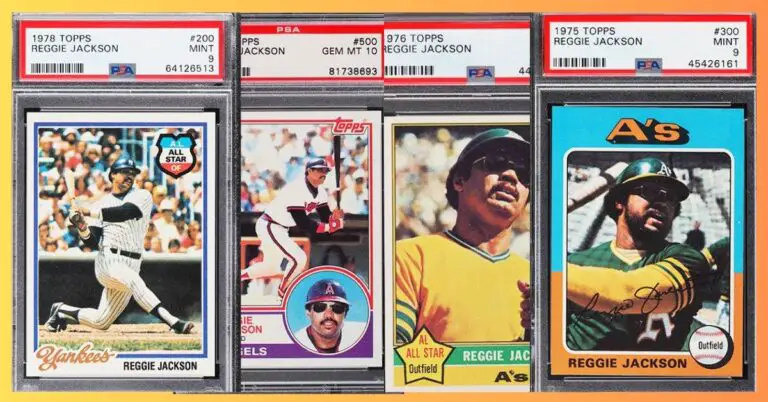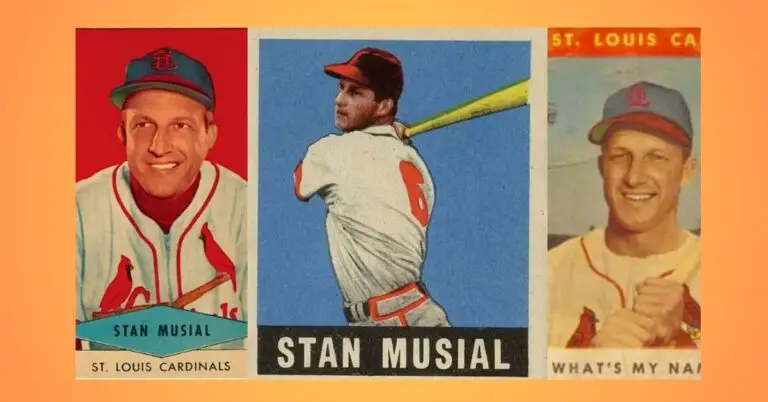Most Valuable 1987 Topps Baseball Cards | TOP 29
In baseball card collection, few sets quite like the 1987 Topps series. Known for its iconic wood-grain design and a plethora of superstar players. This set was printed in staggering quantities, making it a familiar sight to fans and collectors alike. Amidst the commons that flood the market lies an intriguing reality: not all 1987 Topps baseball cards are created equal.
Many may view these cards as mere relics of childhood glory, a select few have emerged as hidden gems worth serious money.
1987 Topps Baseball Cards TOP 29
- 1987 Topps #320 Barry Bonds Rookie Card
- 1987 Topps #170 Bo Jackson Rookie Card
- 1987 Topps #500 Don Mattingly
- 1987 Topps #620 Jose Canseco
- 1987 Topps #606 Don Mattingly All-Star (No TM
- 1987 Topps #757 Nolan Ryan
- 1987 Topps Traded #70T Greg Maddux Rookie Card
- 1987 Topps #200 Pete Rose
- 1987 Topps #366 Mark McGwire
- 1987 Topps #430 Mike Schmidt
- 1987 Topps Traded #74T Fred McGriff Rookie Card
- 1987 Topps #400 George Brett
- 1987 Topps #450 Kirby Puckett
- 1987 Topps #490 Dale Murphy
- 1987 Topps #530 Tony Gwynn
- 1987 Topps #648 Barry Larkin Rookie Card
- 1987 Topps #784 Cal Ripken Jr.
- 1987 Topps #420 Will Clark Rookie Card
- 1987 Topps #606 Don Mattingly All-Star (With Trademark)
- 1987 Topps #735 Rickey Henderson
- 1987 Topps #749 Ozzie Smith
- 1987 Topps #150 Wade Boggs
- 1987 Topps #300 Reggie Jackson
- 1987 Topps #340 Roger Clemens
- 1987 Topps #345 Andre Dawson
- 1987 Topps #425 Tom Seaver
- 1987 Topps #460 Darryl Strawberry
- 1987 Topps #741 Paul Molitor
- 1987 Topps #634 Rafael Palmeiro Rookie Card
1987 Topps #320 Barry Bonds Rookie Card
| Grade | PSA 10 |
| Value | $200 |
This card captures a pivotal moment in both his career and the history of baseball. Despite an uneven start to his journey with the Pittsburgh Pirates, where he struck out more than 100 times in only 413 at-bats, Bonds showcased tantalizing potential that immediately caught scouts’ eyes.
His 1986 performance, slashing .261/.329/.492 with impressive power numbers—25 home runs, nine triples, and 34 doubles—hinted at the future superstar he was destined to become.
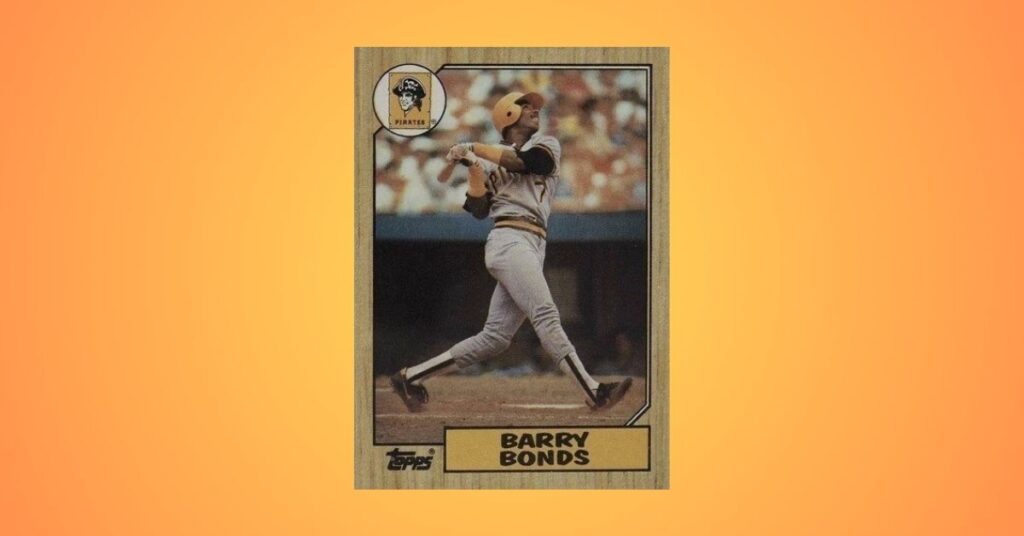
The Pirates saw significant improvement during this time, jumping from a lackluster 64 wins to a more respectable 80 in ‘87. Bonds’ combination of speed and power was electrifying; he swiped over 30 bags for the second consecutive year (32) while setting the stage for his evolution into an MVP-caliber player.
This rookie card not only reflects Bonds’ emerging talent but also symbolizes a franchise on the rise—one that would ultimately be overshadowed by controversy in later decades due to PED allegations.
1987 Topps #170 Bo Jackson Rookie Card
| Grade | PSA 10 |
| Value | $140 |
It encapsulates a momentous period in sports history, as he skillfully balanced two demanding careers in baseball and football. Drafted in the fourth round of the NFL Draft, his signing with the Los Angeles Raiders during the summer of ‘87.
Few had successfully navigated dual-sport aspirations before him. That year saw Jackson’s electrifying speed and athleticism on display, making him a tantalizing prospect both on the diamond with the Kansas City Royals and under center for the Raiders.
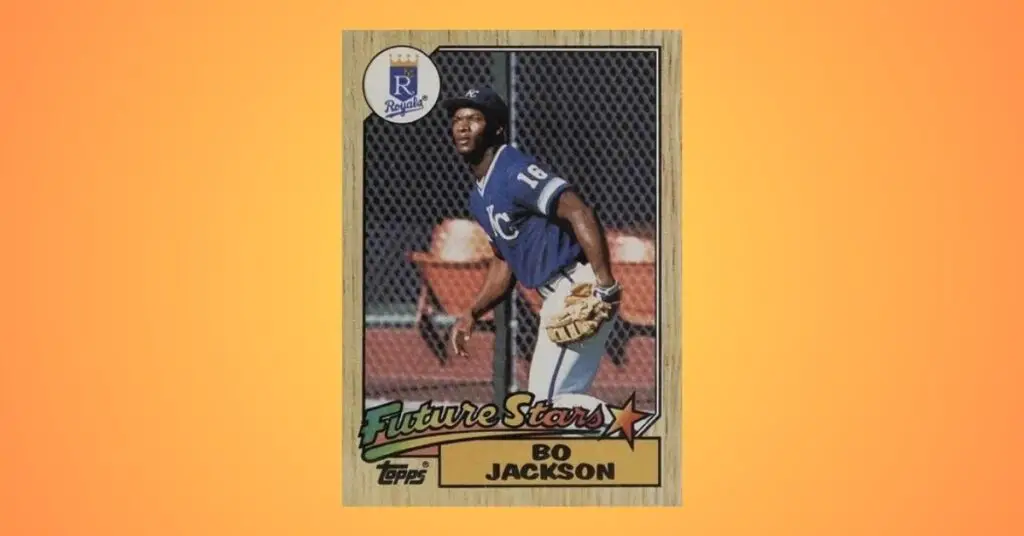
He played only 35 games that MLB season, boasted an impressive .220 batting average combined with standout plays that fueled his legend—like his famous sprinting home run while stealing second base—Jackson did not shy away from football either.
His remarkable performance earned him a spot as runner-up for the NFL Offensive Rookie of the Year Award, Collectors recognize this iconic card not merely for its aesthetic value but also as a testament to Jackson’s groundbreaking approach to athletics. Bo traded helmets for caps and back again between seasons, fans witnessed a transcendent athlete whose legacy would redefine what it meant to excel in multiple sports.
1987 Topps #500 Don Mattingly
| Grade | PSA 10 |
| Value | $110 |
In June 1987, Don Mattingly’s season took a dramatic turn when he suffered a back injury that forced him to miss 21 games. The first baseman’s two protruding disks sidelined him, leading to five days of traction in a New York hospital.
Speculation swirled around the clubhouse about how this star player was injured, with rumors suggesting it happened during a lighthearted wrestling match with pitcher Bob Shirley. Despite this setback, Mattingly returned to the diamond revitalized, storming back with an impressive .370 batting average in his first two weeks after injury and scoring a remarkable 12 runs over just 13 games.
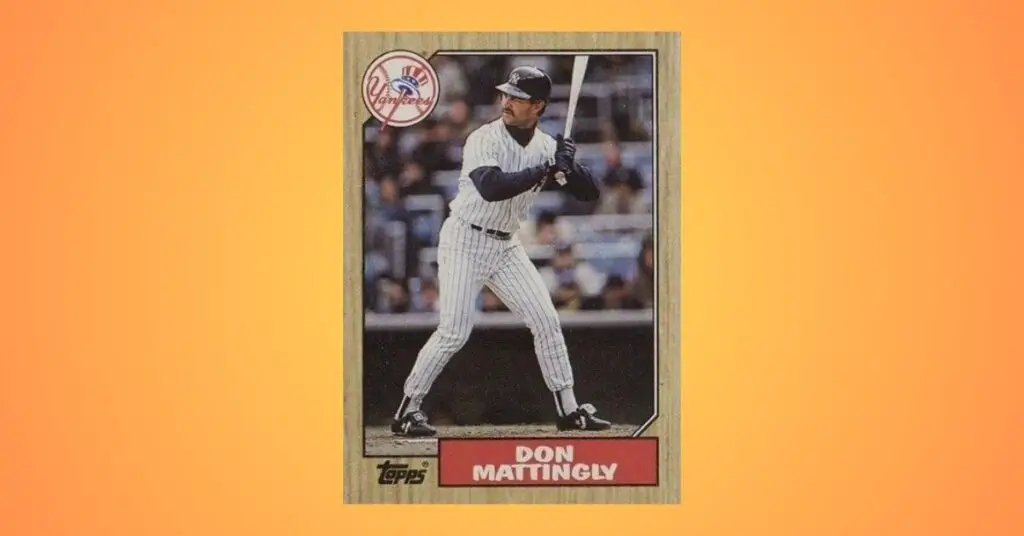
His phenomenal comeback on July 8th when Mattingly launched a three-run homer off Minnesota Twins starter Mike Smithson—a feat that seemed ordinary at the moment but set the stage for extraordinary performances.
Over his next seven games, he not only displayed his power but also scored his name in baseball culture by tying the Major League record for home runs hit in eight consecutive games.
1987 Topps #620 Jose Canseco
| Grade | PSA 10 |
| Value | $100 |
It is not only showcased a pivotal moment in the slugger’s career but also marked the beginning of an iconic chapter for the Oakland Athletics, known as the Bash Brothers. Canseco embraced his role as a powerhouse hitter while nudging aside for rookie Mark McGwire’s dazzling debut.
Fans witnessed an exhilarating one-two punch that catalyzed the A’s dominance. They belted out 80 home runs during the season, culminating in memorable games that left spectators spellbound and set a solid foundation for future championships.
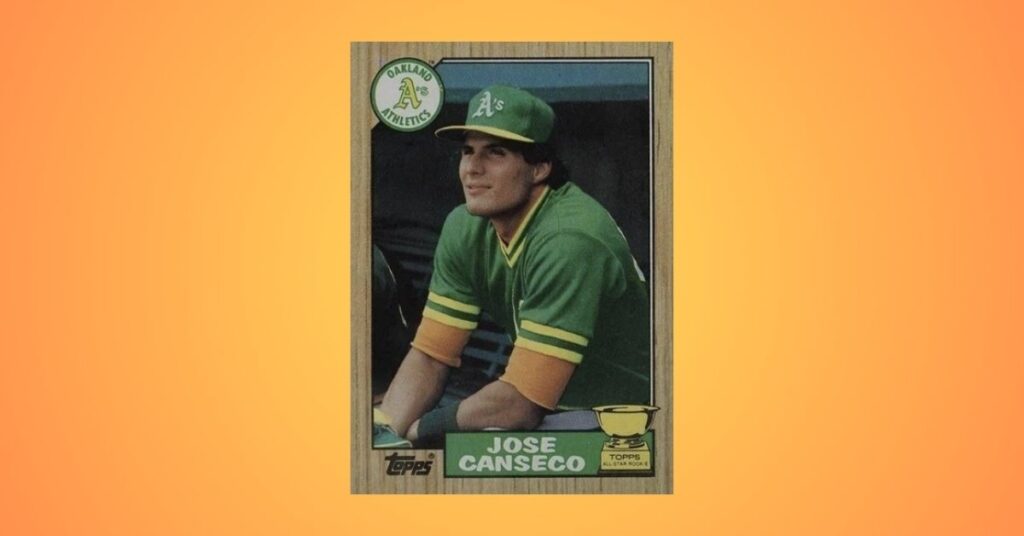
Canseco’s impressive numbers—31 home runs, 113 RBIs, and solid ancillary stats—painted him as a formidable force on the field. However, he faced challenges with strikeouts—a staggering 157 Ks—which somewhat dimmed his light amidst his pursuit of greatness.
His contributions to team success can’t be understated; they revitalized fan post-strike and marked Oakland’s resurgence from mediocrity to championship contention.
1987 Topps #606 Don Mattingly All-Star (No TM
| Grade | PSA 10 |
| Value | $90 |
In an era of power hitters, Mattingly showcased his unique blend of contact hitting and raw power, posting a remarkable batting average of .327 alongside impressive home run and RBI totals.
This card encapsulates a pivotal moment in Mattingly’s career when he became the pride of the New York Yankees, striking fear into opposing pitchers with his stunning ability to deliver in clutch situations—24 of his 115 RBIs came from just six swings.
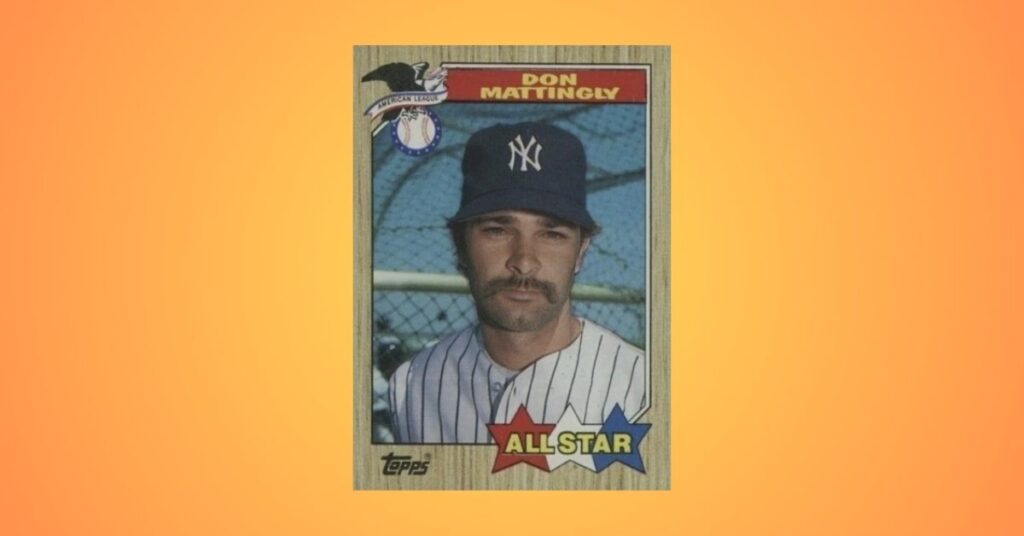
This iconic card exists in two variations due to an error that was corrected later on, making it particularly sought after among enthusiasts of 1987 Topps baseball card.
For these collections or seeking some 1987 Topps most valuable baseball cards. This specific piece serves as both a historical artifact and an expression of ’80s baseball nostalgia, bridging generations through its significance and storytelling charm.
1987 Topps #757 Nolan Ryan
| Grade | PSA 10 |
| Value | $90 |
In 1987 Topps #757 Nolan Ryan baseball cards, The common perceptions is of age and performance in professional sports. Many expected the 40-year-old pitcher to begin a leisurely retirement marked by golf courses and relaxation. He delivered one of his most stellar seasons on the mound.
His ability to lead Major League Baseball in strikeouts with an astonishing 270, combined with dominant metrics like a FIP of 2.47, spoke volumes about his talent as he entered a new decade of life.
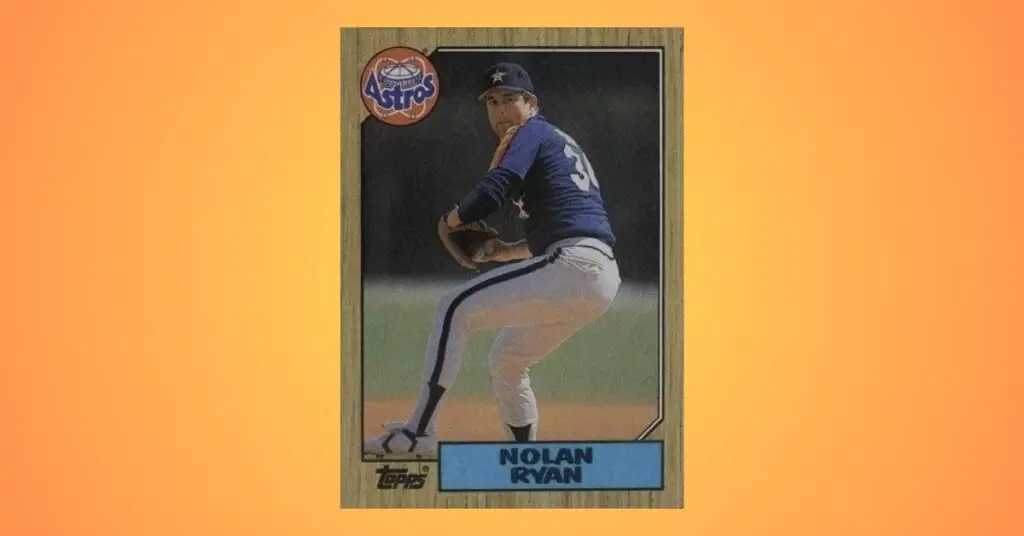
Despite finishing the season with an 8-16 record—largely attributed to inadequate run support—Ryan’s prowess was undeniable.
1987 Topps Traded #70T Greg Maddux Rookie Card
| Grade | PSA 10 |
| Value | $85 |
This card holds a special place not only in the heart of baseball lovers but also 1987 Topps baseball most valuable card. This was an era where Maddux was just beginning to inscribe his name into the annals of baseball history,coming off a tumultuous stint in Triple-A with the Chicago Cubs’ affiliate
Despite struggling with control that season—resulting in a less-than-stellar WHIP—his innate talent shimmer through as he returned to Major League Baseball and laid the foundation for his illustrious career.
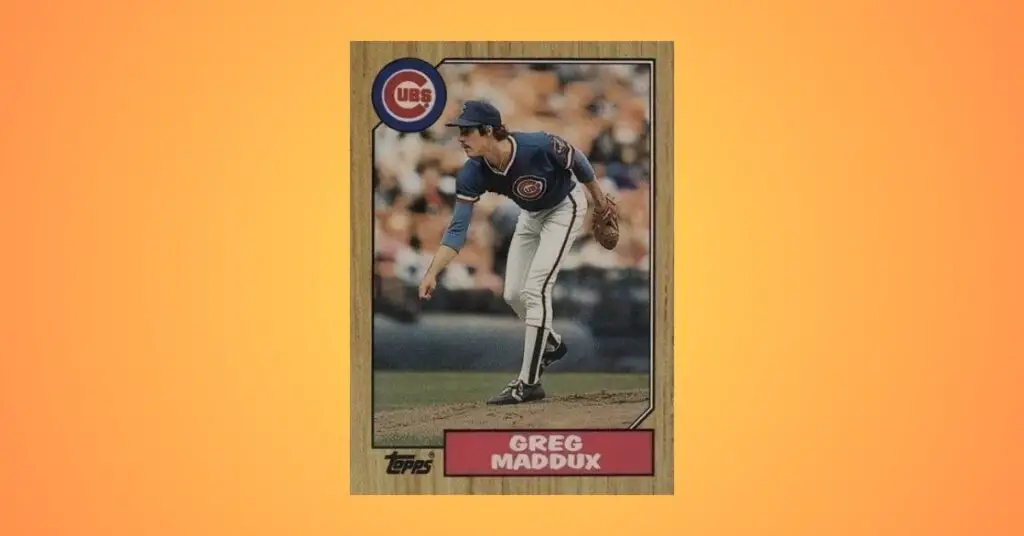
With an impressive record of four consecutive Cy Young Awards, Maddux’s mastery of pinpoint accuracy and strategic speed changes would later redefine pitching excellence.
1987 Topps #200 Pete Rose
| Grade | PSA 10 |
| Value | $80 |
In 1987 Topps #200 Pete Rose baseball cards, Pete Rose last two seasons as player-manager with the Cincinnati Reds were filled with both nostalgia and struggle. Finishing second in the National League in both 1985 and 1986 highlighted his leadership and connection to the team, even as age began to take a toll on his performance.
His .219 batting average in 1986 was starkly below his legendary standards, yet it did not dim the fervor of Reds fans who revered him for breaking Ty Cobb’s long standing record with his monumental 4,192nd hit in September 1985.
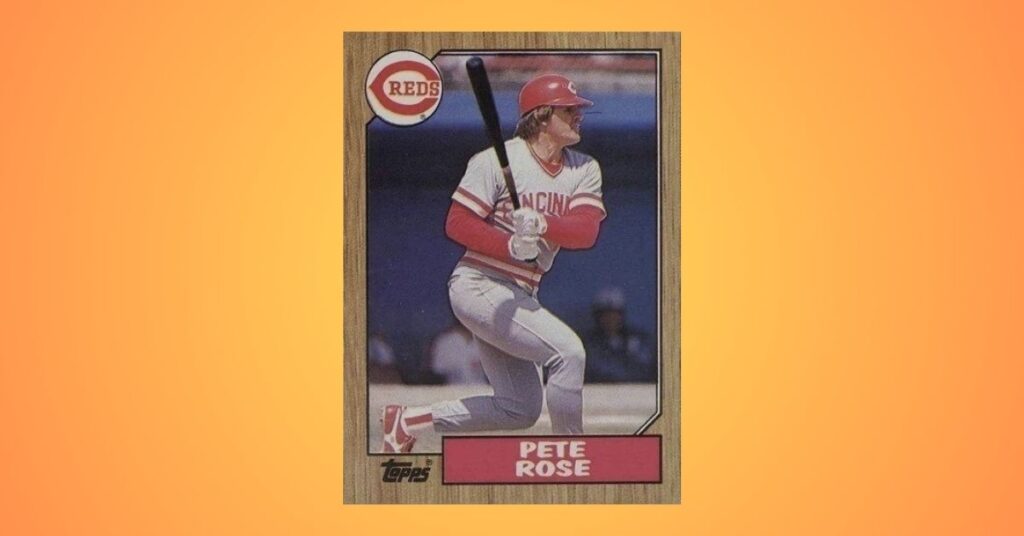
His last All-Star appearance in 1982 seemed like an echo of better days; —the lifetime ban imposed due to gambling scandals that shook the sport.
1987 Topps #366 Mark McGwire
| Grade | PSA 10 |
| Value | $75 |
His 49 home runs not only eclipsed the previous record but also solidified his legacy as one of baseball’s most formidable sluggers. His decision to skip the final game of the season to support his wife during childbirth showcases a side of McGwire that fans often overlooked—his deep commitment to family amidst burgeoning fame.
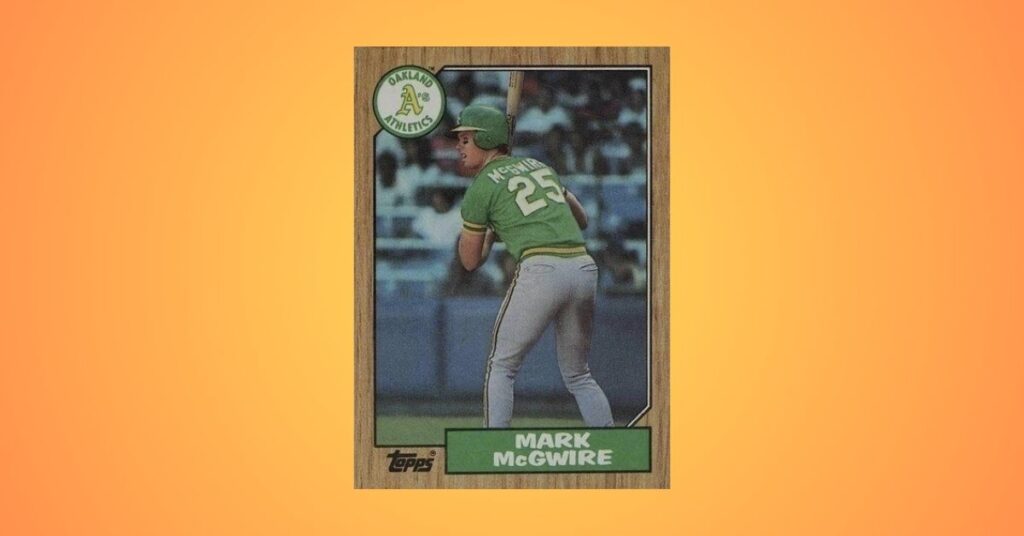
Integral to Oakland’s success in 1987, McGwire topped all hitters with a .618 slugging percentage and boasted an impressive .289 batting average. This remarkable performance earned him an All-Star nod and made him only the second player in American League history, after Carlton Fisk, to win Rookie of the Year unanimously—a testament to both his skill and charisma on the diamond.
1987 Topps #430 Mike Schmidt
| Grade | PSA 10 |
| Value | $75 |
At the age of 37 he was more than just a player; he was the embodiment of Phillies baseball. When he connected with that knee-high fastball for his historic 500th home run, it wasn’t just a milestone for Schmidt
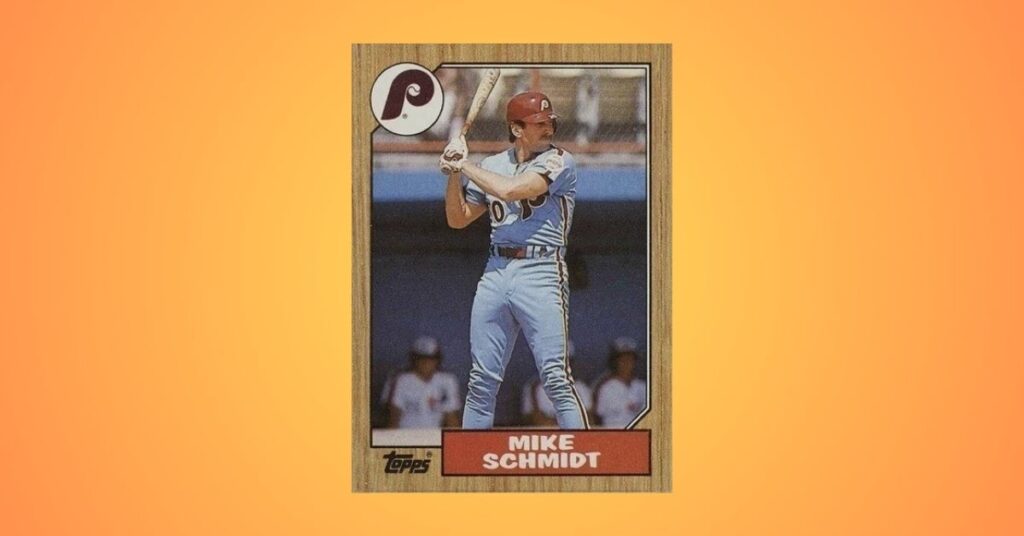
It marked an emotional moment for fans who had watched him elevate the franchise to its former glory during the late ‘70s and early ‘80s. The standing ovation from the crowd underscored the deep connection between him and Philadelphia, a bond forged through countless memorable moments.
1987 Topps Traded #74T Fred McGriff Rookie Card
| Grade | PSA 10 |
| Value | $60 |
McGriff showcased his immense potential with the Toronto Blue Jays that year. In just 295 at-bats, he blasted an impressive 20 home runs and demonstrated keen plate discipline with a stellar .376 on-base percentage.
This stellar performance marked him not only as an essential player for the Jays but also as a burgeoning star within Major League Baseball.
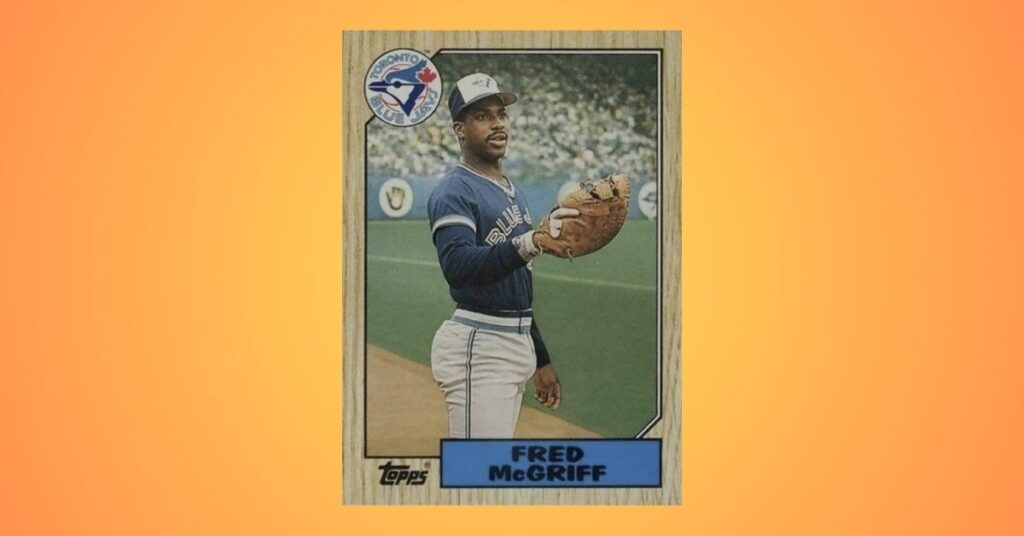
Beyond his impressive stats, McGriff’s influence extended into pop culture when he became a standout figure in Emanski’s Defensive Drills video, which captivated young fans and aspiring athletes throughout the ’90s.
The convergence of talent, timing, and media presence made Fred McGriff’s ascent unforgettable—and his rookie card is a lasting tribute to that legacy.
1987 Topps #400 George Brett
| Grade | PSA 10 |
| Value | $55 |
It is more than just a snapshot of a legendary player; That year marked a turbulent period for Brett, who battled injuries that saw him on the disabled list multiple times. He suffered a rib injury early in the season followed by a partially torn MCL on his 34th birthday—Brett returned to the diamond with an undeterred spirit, proving why he was one of baseball’s greats.
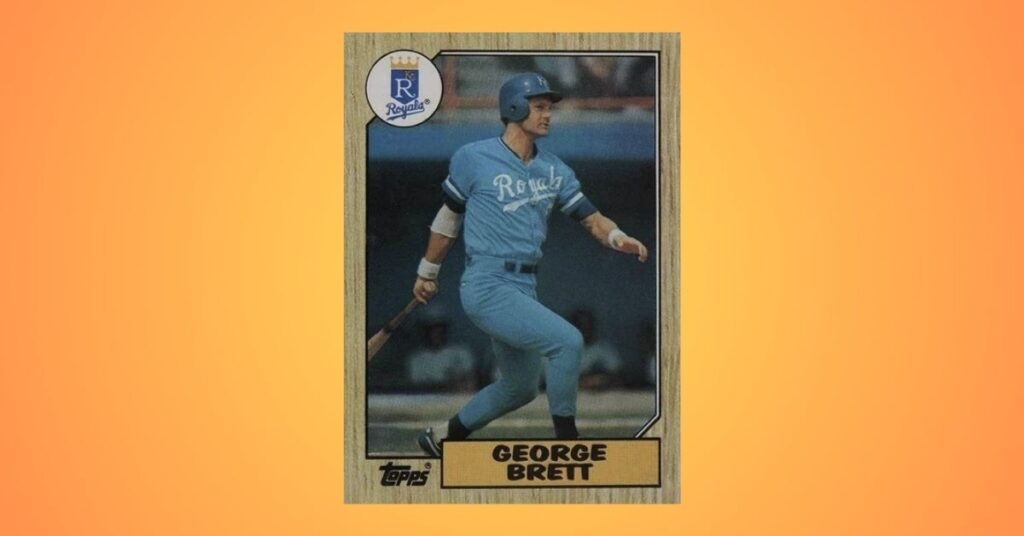
Despite these challenges, Brett delivered impressive numbers during the 1987 season, boasting a slash line of .290/.388/.496 and contributing significantly with 22 home runs and 78 RBIs over just 115 games.
His performance in this thunderous year not only solidified his status the most valuable players in Major League Baseball but also elevated his card’s worth among collectors aiming for those coveted pieces from Topps’ iconic set.
1987 Topps #450 Kirby Puckett
| Grade | PSA 10 |
| Value | $55 |
He transformed the Minnesota Twins into a powerhouse amid fierce competition within the AL East. His impressive slashes of .332/.367/.537, paired with 28 home runs and stellar defensive prowess in center field, positioned him as a dual threat who consistently delivered when it mattered most.
Puckett’s blend of power and finesse resulted in an astounding 207 hits—an accomplishment that marked the beginning of his streak as leader in that category for three consecutive seasons.
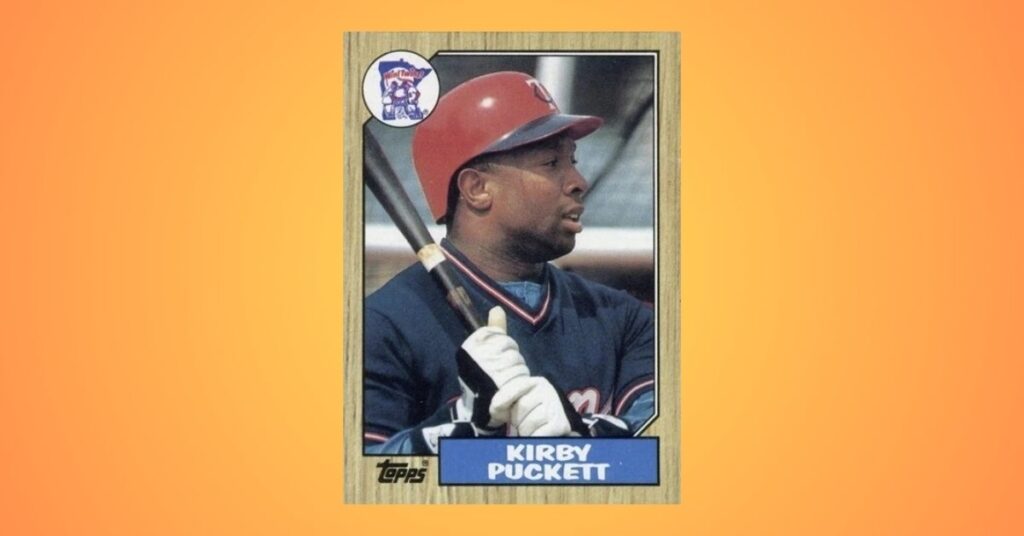
In Game 6 against elimination, his ability to reach base five times helped fuel an 11-5 victory that breathed life back into the Twins’ World Series hopes. He played a key role in clinching the championship title during Game 7—a crowning achievement cemented by his clutch performance at such a pivotal moment.
This combination of individual excellence and team triumph not only solidified Puckett’s legacy but also turned him into the most cherished figure in baseball history.
1987 Topps #490 Dale Murphy
| Grade | PSA 10 |
| Value | $55 |
That year marked Murphy’s peak, he unleashed an offensive firestorm with an astounding 44 home runs—a career-high that would come to define his legacy. His ability to draw walks—115 in total, including a staggering 29 intentional ones during an era when the Atlanta Braves struggled offensively.
His tremendous performance and unparalleled .997 OPS, Murphy found himself outside the top ten in NL MVP voting, emphasizing how fleeting recognition can be for even the most accomplished players.
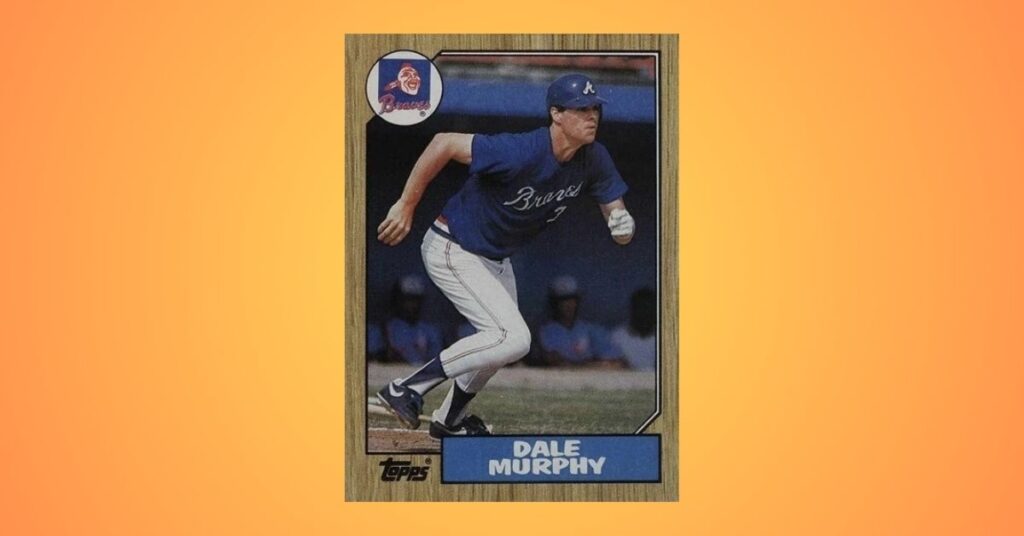
Dale Murphy’s career arc serves as a sorrowful reminder of how injuries can alter destinies. With two or three more seasons replicating his standout performance from ‘87, Cooperstown may have been calling his name instead of merely being enshrined on treasured cards like the iconic 1987 Topps set.
A rare moment where talent clashed with circumstance, leaving fans and collectors pondering what might have been had fortune smiled differently upon this two-time MVP winner.
1987 Topps #530 Tony Gwynn
| Grade | PSA 10 |
| Value | $55 |
It is a snapshot of an extraordinary season against the backdrop of the San Diego Padres’ struggles. While the team itself was experiencing a decline, dropping from their NL championship triumph in 1984 to alarming losses in subsequent years, Gwynn shone as a beacon of individual excellence amid adversity.
His remarkable .370 batting average and MLB-best 218 hits illustrated his uncanny ability to make contact, his ability to connect for doubles (36), triples (13), and even home runs (14) marked an evolution in his game that many fans had eagerly awaited.
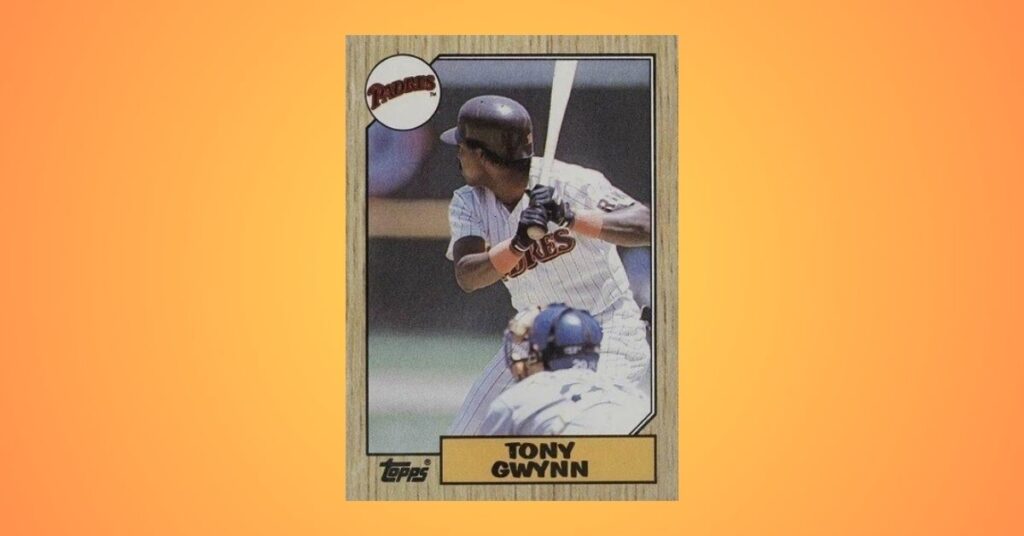
This piece captures not just Gwynn’s impressive stats but also the spirit of resilience present in sports—a shining light during a darker time for the Friars. Gwynn’s legacy: two Gold Gloves, three Silver Slugger awards, and an indelible mark on baseball history despite playing for a light-hitting team with subpar pitching.
1987 Topps #648 Barry Larkin Rookie Card
| Grade | PSA 10 |
| Value | $55 |
He put on the Cincinnati Reds uniform that year, overcoming the challenge posed by Kurt Stillwell, Larkin quickly proved his mettle on the field. His impressive performance—highlighted by 12 home runs and exceptional defensive prowess—injected new life into a team that was eager to reclaim its glory days.
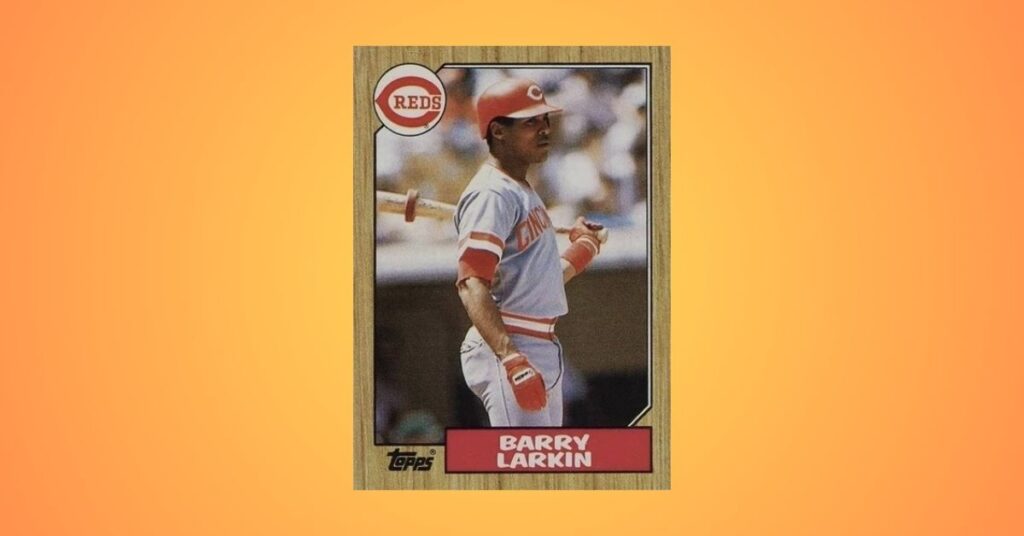
The most valuable from the iconic 1987 Topps baseball card series due to its rarity and Larkin’s eventual Hall of Fame status. With a batting average of .244, paired with speed on the bases reflected in his 21 stolen bases, Larkin showcased versatility that few could match.
It symbolizes not just a promising start to a legendary career but embodies an era when players like him transformed their franchises into contenders once again.
1987 Topps #784 Cal Ripken Jr.
| Grade | PSA 10 |
| Value | $55 |
The season unfolded in unfortunate circumstances as the team slumped from a respectable 73 wins to just 67, and injuries ravaged their pitching staff, hindering any hope for improvement.
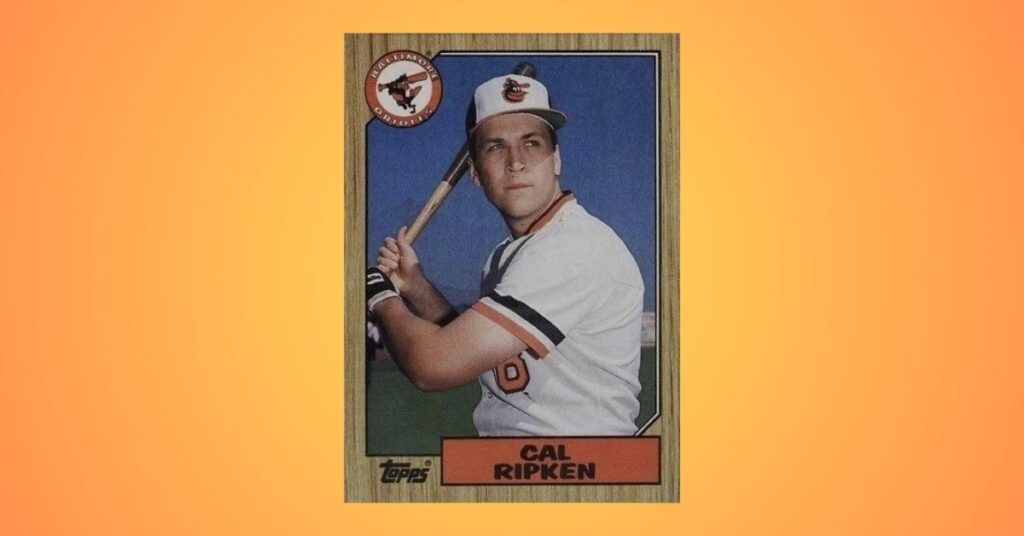
Despite personal setbacks—recording career worsts in batting average (.252) and OPS (.769)—Cal still showcased his power-hitting prowess with 27 home runs and 98 RBIs, reminding fans of his remarkable talent even in adversity.
1987 Topps #420 Will Clark Rookie Card
| Grade | PSA 10 |
| Value | $50 |
Will Clark’s journey from a rookie sidelined with an elbow injury in 1986 to a powerhouse in the 1987 season. After missing a quarter of his inaugural campaign, Clark returned revitalized, eager not just to reclaim his status but to elevate it.
The New Orleans native transformed his swing, dramatically increasing his power output and becoming a cornerstone of the San Francisco Giants’ offense. Hitting one home run every 15.1 at-bats—a stark contrast to his previous ratio—Clark’s performance was nothing short of electrifying.
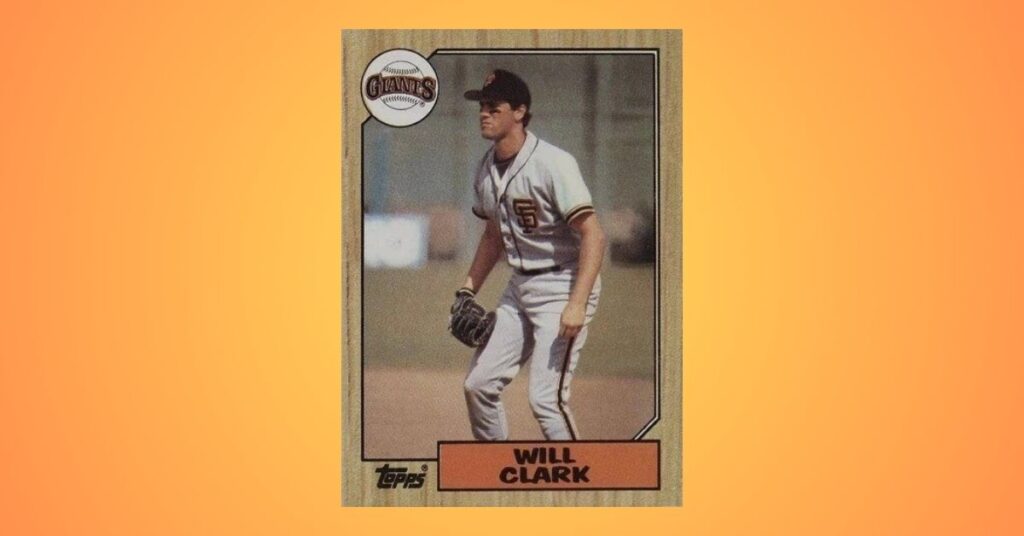
His impressive .308 batting average coupled with 35 home runs propelled him into the spotlight, leading a Giants team that had languished in mediocrity for years back toward contention. As he showcased both power and elite fielding skills at first base.
Clark played an instrumental role in the team’s resurgence, culminating in their first NL West title since 1971. His remarkable season did not go unnoticed; finishing fifth in the MVP race and earning multiple All-Star appearances from 1988 to 1992 solidified his status one of baseball’s elite talents during that era.
1987 Topps #606 Don Mattingly All-Star (With Trademark)
| Grade | PSA 10 |
| Value | $50 |
Don Mattingly All-Star card holds a special place in the hearts of collectors, particularly during a time when baseball was seeing explosive growth in popularity. Released at the height of Mattingly’s career, an era marked by fierce competition and extraordinary players like Ryne Sandberg.
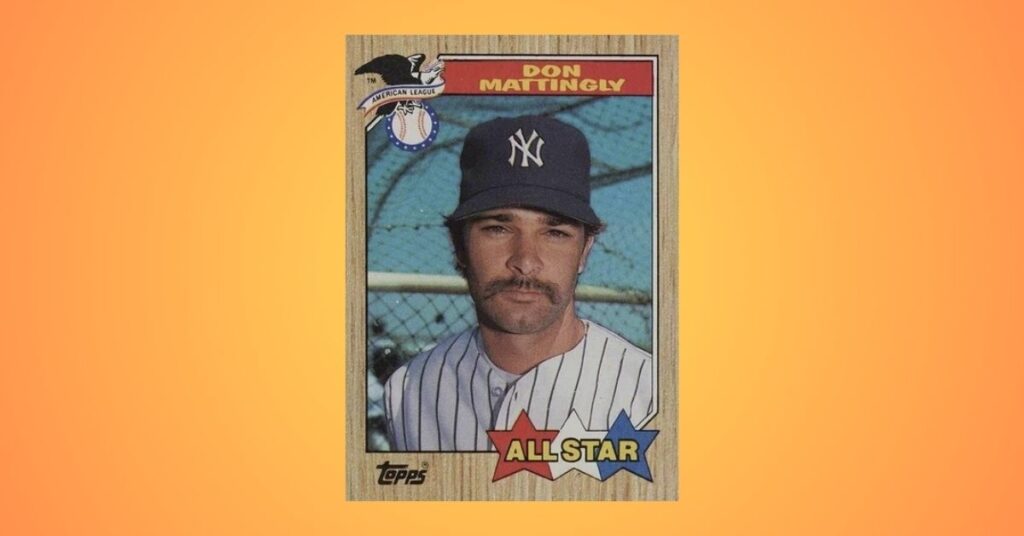
Sandberg faced challenges with injuries that year, he demonstrated resilience, maintaining impressive offensive numbers despite missing close to a month due to a sprained ankle.
His bounce-back performance, highlighted by a .294 batting average and an .809 OPS, reminds fans that even stars can face hardships yet still shine brightly.
1987 Topps #735 Rickey Henderson
| Grade | PSA 10 |
| Value | $50 |
Rickey Henderson, numbered 735, captures a pivotal moment in his career marked by resilience against injury. Despite battling a nagging right hamstring issue that sidelined him for nearly two months, Henderson managed to put together an impressive season.
His ability to maintain an elite offensive performance—finishing with a .291 batting average alongside 17 home runs and an astounding on-base percentage of .423—highlights both his raw talent and determination.
It’s fascinating how he managed to steal 41 bases in just 95 games, proving that even at less than full strength, he remained one of the most electrifying players on the field.
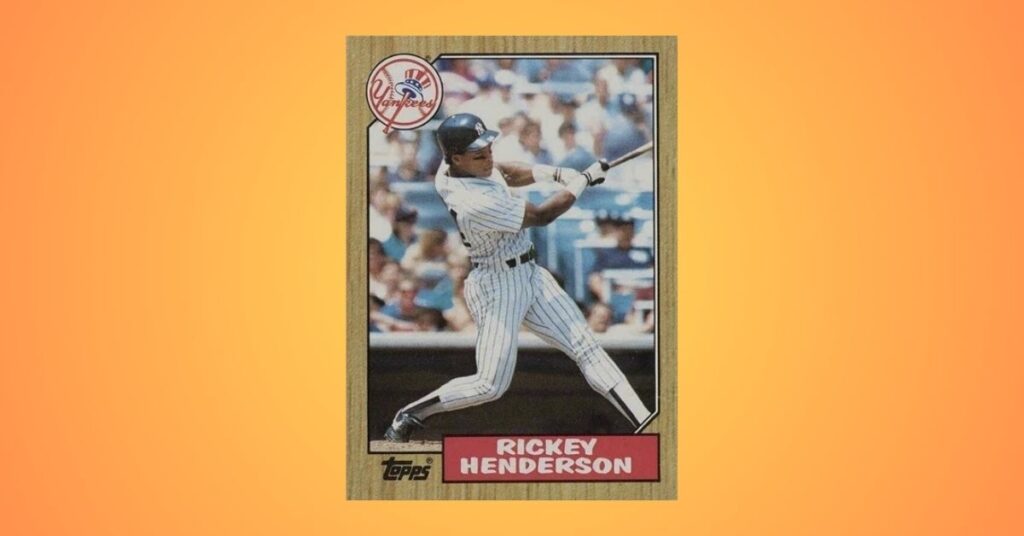
The tension surrounding Henderson’s situation also provides insight into his competitive spirit; manager Lou Piniella’s decision to keep him on the field speaks volumes about their mutual expectations for success during an ‘89-win season.
The incident reflected not only Henderson’s physical prowess but also the psychological pressures athletes often face when dealing with injuries amidst team ambitions.
1987 Topps #749 Ozzie Smith
| Grade | PSA 10 |
| Value | $45 |
Ozzie Smith’s 1987 as a testament to the remarkable versatility of this Hall of Fame shortstop. During a career often overshadowed by more powerful hitters, Smith’s performance that year defied expectations; he achieved a rare feat for players in his position by hitting over .300, showcasing that defense alone couldn’t define his legacy.
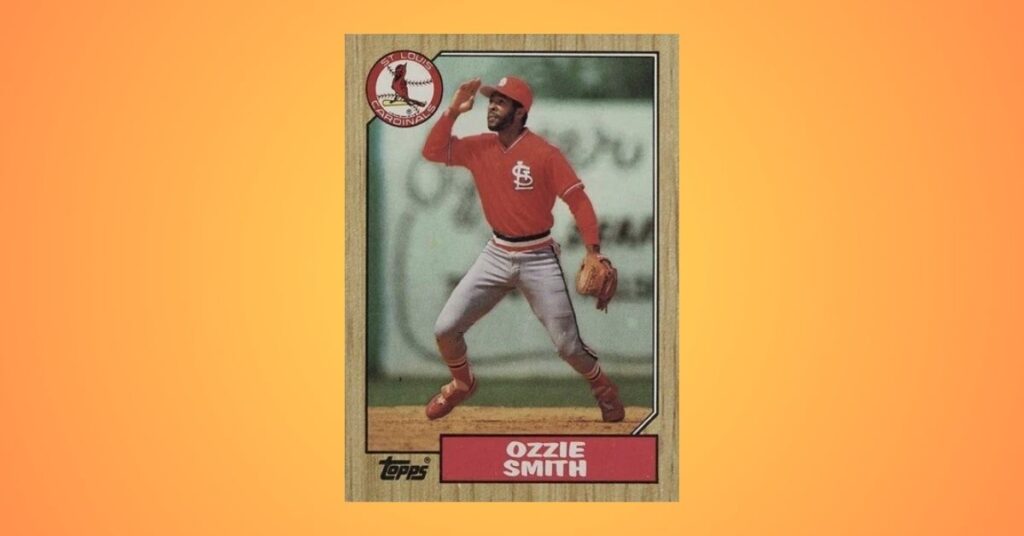
Smith’s unique blend of exceptional defensive prowess and newfound offensive production transformed him into one of the most valuable assets for the 95-win Cardinals.
Though he faced struggles at the plate during critical postseason games against teams like the Giants and Twins, his impact on the field remained irreplaceable.
1987 Topps #150 Wade Boggs
| Grade | PSA 10 |
| Value | $40 |
The Wade Boggs card, capturing a moment in time when his batting prowess reached extraordinary heights. .485 average and an eye-popping .581 on-base percentage. Such figures not only reflect dominance at the plate but encapsulate Boggs’ strategic understanding of hitting that could make any statistician’s heart race.
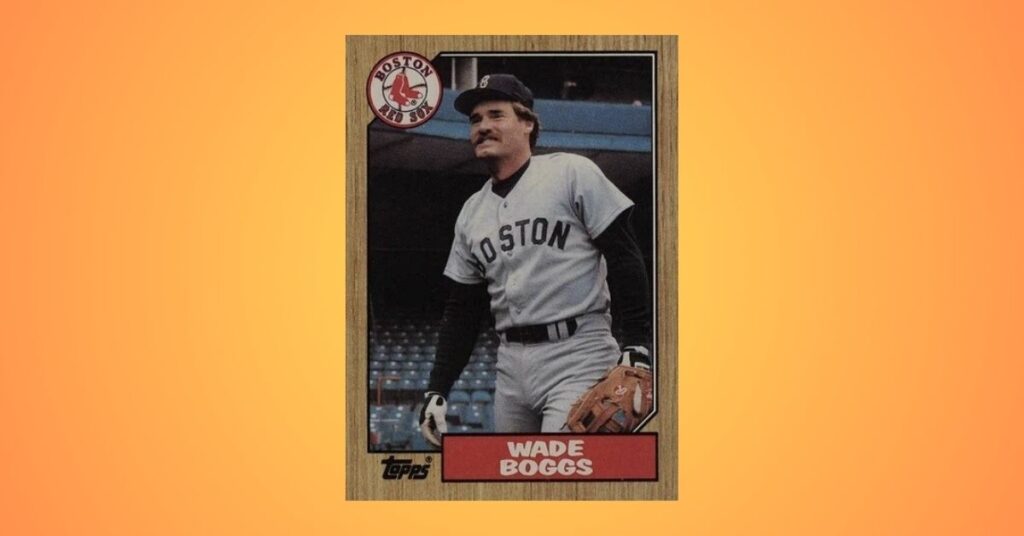
Wade Boggs card lies in its connection to history—a tangible reminder of a player at his peak who redefined expectations for hitters in Major League Baseball. With multi-hit games becoming routine during that unforgettable month, and a total of 24 home runs setting him apart from previous seasons,
As Boggs grabbed hold of yet another AL batting title with an impressive .363 average, investors recognized this as not just a symbol of individual success but also as an emblematic piece reflecting the competitive landscape of baseball during one transformative era.
1987 Topps #300 Reggie Jackson
| Grade | PSA 10 |
| Value | $40 |
Reggie Jackson of baseball history, encapsulating the essence of a legend navigating his farewell tour. Signing with the Oakland Athletics at age 41, Jackson embraced a final season filled with nostalgia and reflection, marked by countless farewell ceremonies that charmed fans across American League cities.
His decision to make headlines on April 18th by boldly stealing home against Seattle Mariners catcher Bob Kearney was emblematic of his competitive spirit—even in the twilight of his career, he was still showcasing moments that left us in awe.
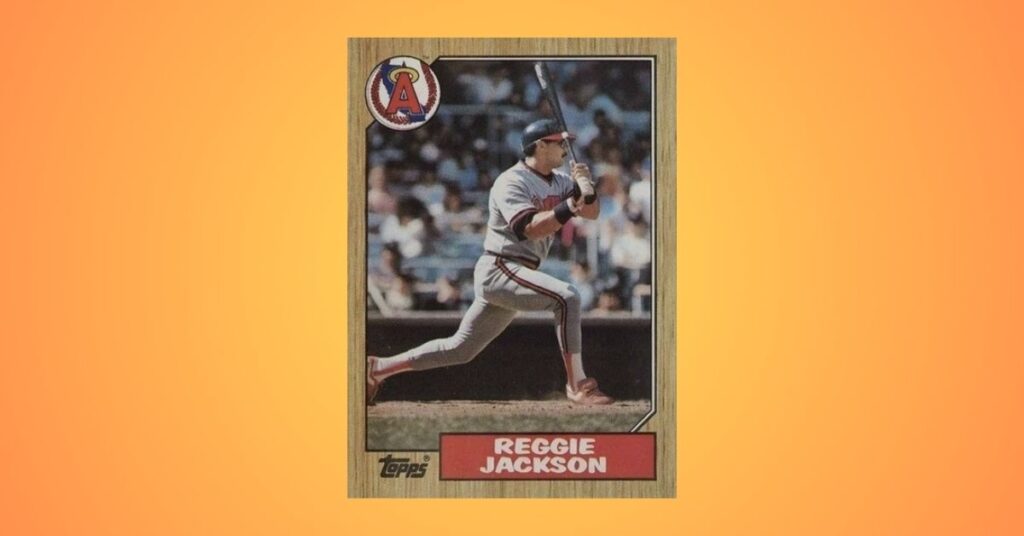
Despite batting just .220 and nearing the end of a storied journey punctuated by record strikeouts—2,597 in total—Jackson remained an integral figure within the game.
The juxtaposition of declining statistics with memorable highlights illustrates not only the struggles but also the resilience that defined his time on the field.
1987 Topps #340 Roger Clemens
| Grade | PSA 10 |
| Value | $40 |
The first American League pitcher to win back-to-back Cy Young Awards in over a decade, Clemens not only dominated on the mound but also set durability records that showcased his resilience and tenacity.
With a staggering 281.2 innings pitched and 18 complete games, he exemplified what it meant to be both an ace and a workhorse for the fifth-place Boston Red Sox.
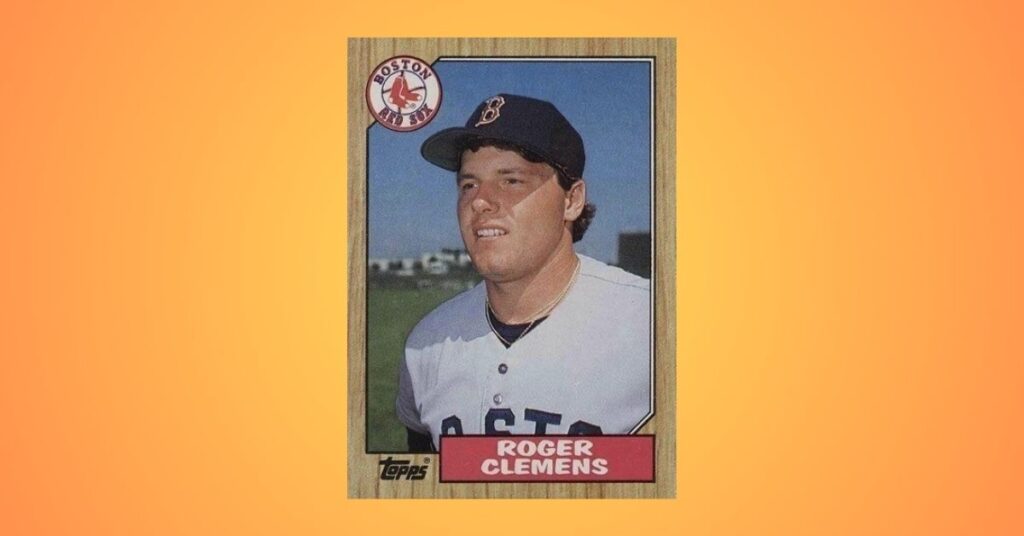
In part to MLB’s experimentation with juiced baseballs—Clemens’s achievement stands out even more. Despite an uptick in runs scored around him, his adjusted stats reveal the mastery behind his performance; he struck out 256 batters while maintaining a commendable 2.97 ERA and leading the league with an impressive strikeout-to-walk ratio of 3.08.
1987 Topps #345 Andre Dawson
| Grade | PSA 10 |
| Value | $40 |
Andre Dawson After years of battling injuries on the unforgiving turf of Montreal’s Olympic Stadium, Dawson faced uncertainty when he signed a modest $500,000 deal with the Chicago Cubs—the lowest salary for any regular on the team that year.
What followed was nothing short of extraordinary; he channeled all his pent-up frustration into a season for the ages, leading Major League Baseball with 49 home runs and 137 RBIs. This shocking turnaround captured not only statistics but imaginations.
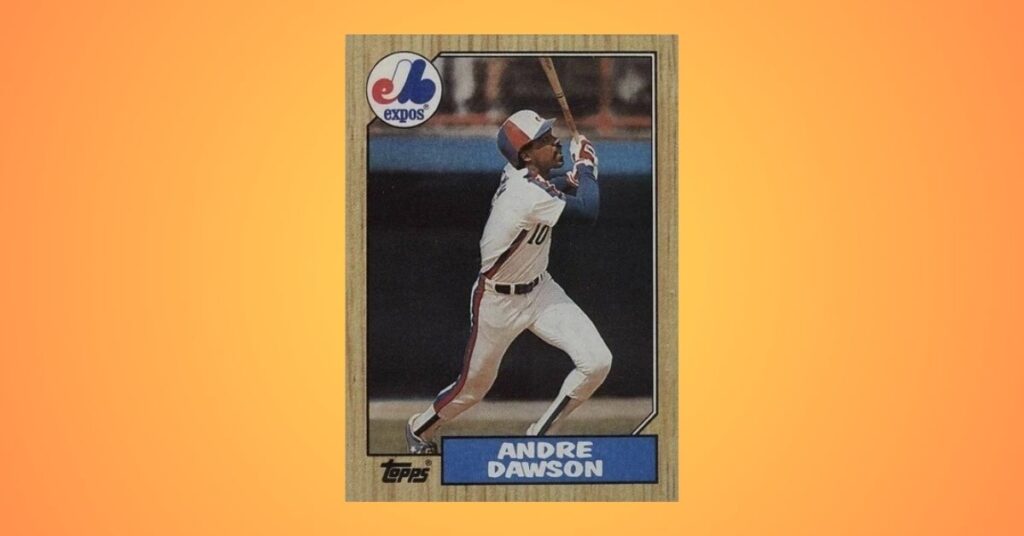
Dawson’s MVP-worthy performance in 1987 underscored his determination and passion for the game, ultimately winning him baseball’s most coveted individual award. While players like Ozzie Smith and Jack Clark were formidable opponents, it was Dawson’s ability to rise above adversity that resonated deeply with voters.
1987 Topps #425 Tom Seaver
| Grade | PSA 10 |
| Value | $40 |
Tom Seaver is one of baseball’s greatest pitchers. After enjoying a strong resurgence with the Chicago White Sox in 1985, Seaver faced an unexpected decline over his final years in Major League Baseball, splitting time between Chicago and Boston.
Even at the age of 42, his return to the New York Mets for a second reunion was steeped in nostalgia and reverence—an emotional chapter that delighted fans who revered him as Tom Terrific.” While he eventually found himself back at Triple-A during this stint, this card serves as a reminder not just of his formidable skills on the mound but also of his enduring legacy.
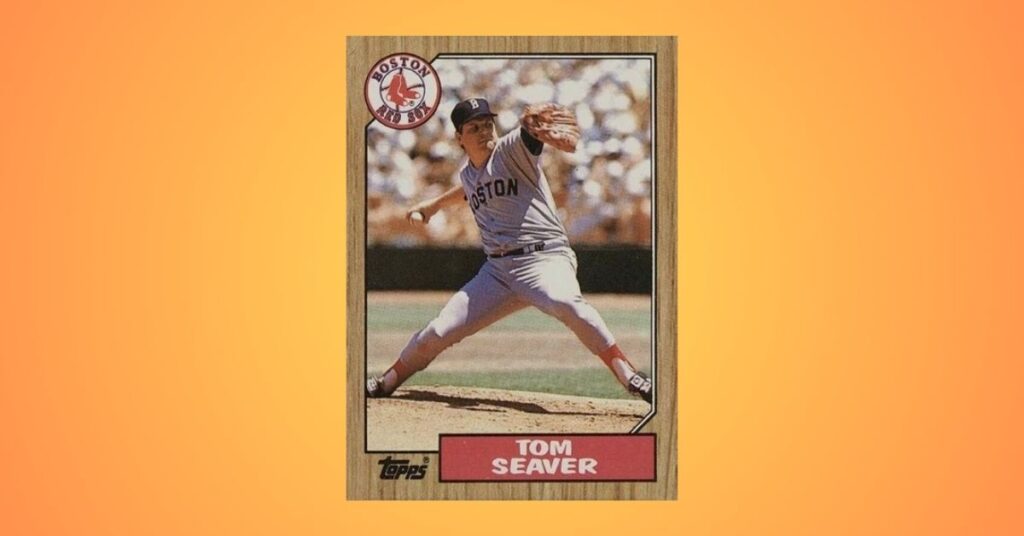
In 1992, following his retirement from professional play, Seaver made headlines once again when he was inducted into the Hall of Fame with an astonishing approval rating of 98.8%, capturing hearts and accolades alike.
1987 Topps #460 Darryl Strawberry
| Grade | PSA 10 |
| Value | $40 |
Darryl Strawberry showcased an athlete at the height of his prowess while simultaneously teetering on the brink of personal turmoil. Boasting staggering statistics like 39 home runs and an impressive .398 on-base percentage, Strawberry was not just a star; he was a game-changer for the New York Mets.
His ability to blend power with finesse made him the most valuable players of that year, reflecting why collectors cherish this particular card among the most valuable 1987 Topps baseball cards.
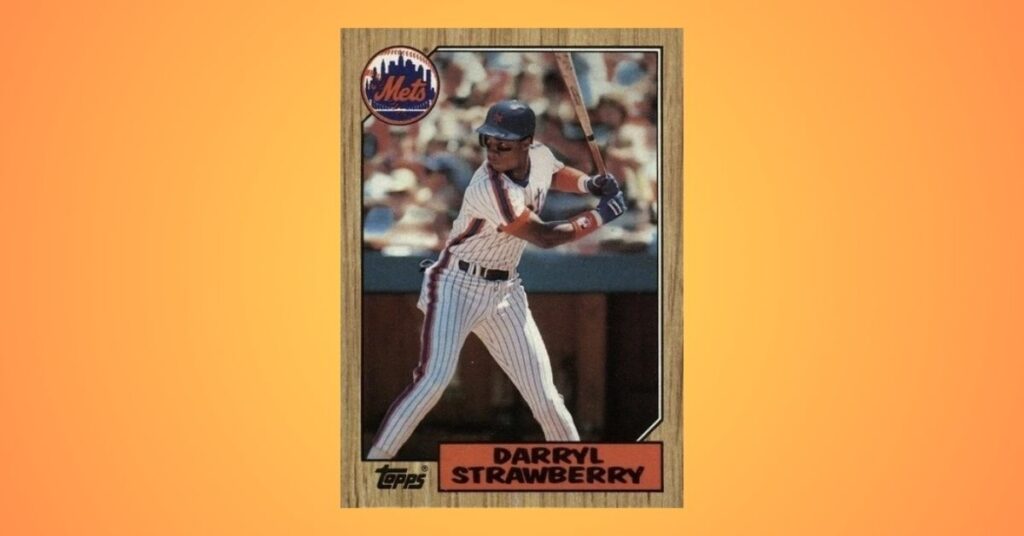
Strawberry’s off-field struggles with substance abuse were beginning to seep into public consciousness, casting a shadow over his accomplishments and raising questions about his long-term legacy.
1987 Topps #741 Paul Molitor
| Grade | PSA 10 |
| Value | $40 |
Paul Molitor showcases a player whose career is often overshadowed by injury struggles, yet still shines brightly in MLB history. Despite battling significant health issues that sidelined him for more than a quarter of the season, Molitor’s phenomenal beginning—hitting an astounding .395 across the first 20 games—demonstrated his unyielding drive and talent.
His performance propelled the Milwaukee Brewers through an impressive 18-2 stretch, temporarily placing them atop the league standings and igniting hope among fans.
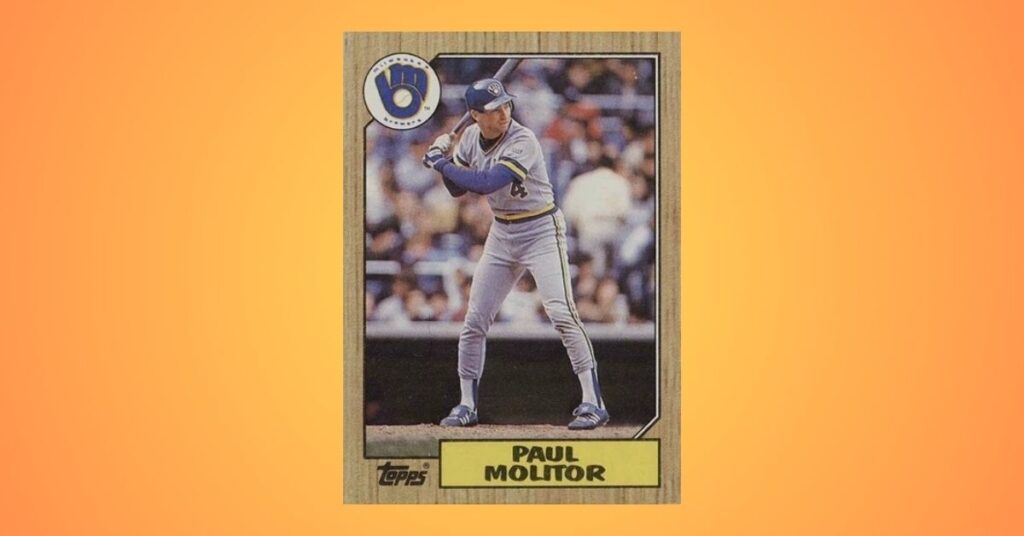
Molitor’s resilience culminated in a remarkable 39-game hitting streak, earning him recognition baseball elite hitters. This feat not only tied him with legends like Ty Cobb but also underscored his ability to adapt when relegated to designated hitter duties later that year.
The fact that he was left on deck during Rick Manning’s game-winning hit speaks volumes to both his critical role on the team and the bittersweet nature of sports where timing can dictate legacy.
1987 Topps #634 Rafael Palmeiro Rookie Card
| Grade | PSA 10 |
| Value | $35 |
Rafael Palmeiro After showcasing his hitting prowess in the minor leagues, Palmeiro burst onto the scene with the Chicago Cubs, where he quickly became a beacon of hope during a challenging season.
With an impressive .276 batting average and an OPS near .900 during his rookie year, it was evident he was destined for stardom—making this card the most valuable within the expansive realm of 1987 Topps baseball cards.
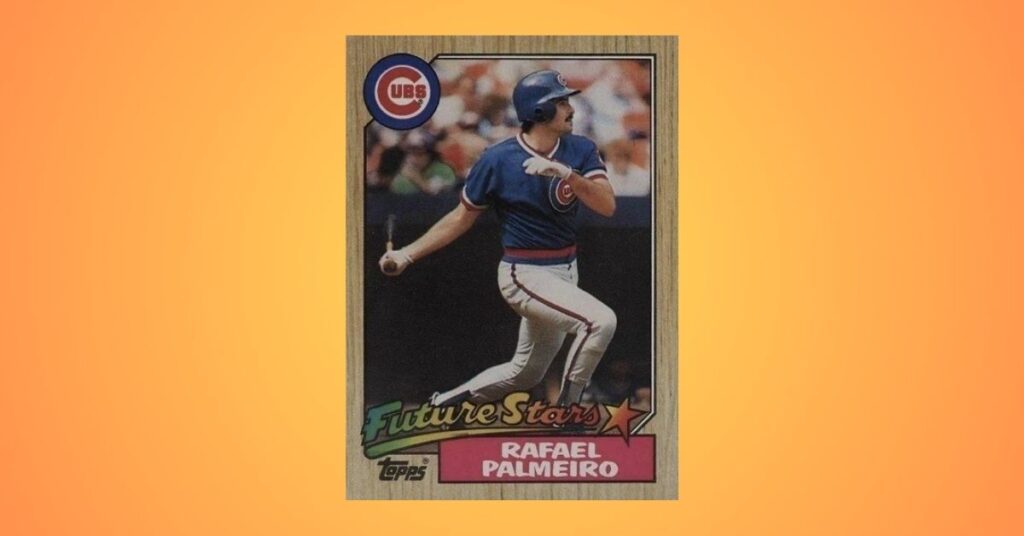
Despite his talent and early promise, Palmeiro’s career would later be embroiled in controversy surrounding performance-enhancing drugs. This shadow did not erase his achievements but added complexity to how we view him as both a player and a person.
His trajectory—marked by remarkable highs such as four All-Star selections—is now seen through dual lenses: that of an elite slugger who never fully realized his potential in terms of accolades and that of a cautionary tale amidst baseball’s evolving narrative on integrity.
Conclusion
The 1987 Topps baseball cards set remains a beloved staple among collectors, showcasing some of the most iconic players in Major League Baseball history. With cards featuring legends like Barry Bonds and Bo Jackson, this set holds significant value for both nostalgic fans and serious investors alike. Understanding the market trends and rarity of specific cards can greatly enhance a collector’s strategy when building their collection.
FAQs
What are the Most Valuable 1987 Topps Baseball Card?
The most valuable cards include key players like Barry Bonds, Bo Jackson, and Greg Maddux, with special variations and graded versions commanding higher prices.
How can I Determine the Value of my 1987 Topps Baseball Card?
You can assess their value by checking current market prices on auction sites, consulting price guides, or getting them appraised by a professional.
What Factors affect the Value of a 1987 Topps Baseball Card?
Key factors include player popularity, card condition (graded vs. ungraded), rarity, and demand within the collector community.
Are there any Errors or Variations in the 1987 Topps set that are Particularly Valuable?
Yes, certain error cards and rare variations, such as those featuring different team logos or misprints, can be worth significantly more than standard issues.
